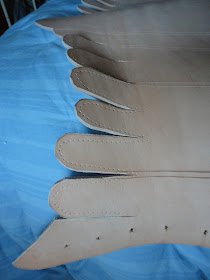When last we were gathered together, this is what we had:
Sometimes, words aren't enough.
As I mentioned previously, my material was a thick n' fabulous faux-suede left over from an upholstery project. I was able to transfer the entire pattern onto the suede without piecing the material, which is ideal. Since the final stays will be cut from a continuous piece of leather, this allows me to recognize any obvious issues with the fit.*
* If you plan to make your stays front AND back-lacing, then obviously, your material should be prepared in two pieces (or more) for the mock-up. There are a pair of child's leather stays in What Clothes Reveal that are adjustable in the front, back and at both sides.
You can see here some of the remaining lines from adjusting my paper pattern:
I don't know why I'm barefoot in all of these. Really.
Everywhere that I felt a little insecure about my lines, I left extra material. You can always trim! At this point, I basted a small pocket at the base of the front center and marked the exact center of the stays, where a busk would go if you were to legitimately use one. Not that I know how to use a busk illegitimately, but...
Then, just like a Viking, stick the busk into the pocket, line it up and secure it with some highly suspect zig-zaggy basting. I marked the lacing holes and used the awl to pierce the material and widen the holes.
If you listen closely, you can hear the busk quietly weeping.
I don't have any pictures of the next part (be grateful), but basically I tried it on, laced it securely using the large needle threaded with string, and made notes on the fit. For me, the main issues were the height of the back (too high), the tabs (too long) and the overall width (a bit big). I treated the mock-up just like the paper pattern; I tried it on, marked it and fitted it several times.
See the peaky-pointy things on either side of the busk? I used those to orient the stays as I tried on the pattern and mock-up. I knew where I wanted those to hit on my body, so as I made changes to the fit, I had a visual reference.
Time to hack up some leather!
It puts the lotion on its skin...
Once you've had a shot of whiskey and decided that your pattern is as good as it's going to get, trace it onto a piece of leather with a soft pencil. Leather has a natural grain, just like fabric has a woven grain.So leather has a "straight" and a "bias" just like fabric does. You can generally orient yourself with the grain of a given piece of leather by looking at the natural stretch marks and lines in the leather. (If it's thin enough, you can gently pull it to find the straight and bias. Your stays leather will likely be too thick for this trick, though.) Ideally, cut the stays on the straight of the grain. "Give" is good, "stretch" is bad.
After you trace the perimeter of the pattern with the pencil, go over it slowly several times with the razor. Over, and over and over and... you get the idea. Don't try to save time and cut really deep the first pass or two! This is where it's important to be patient. I scored the leather with the blade about 10 times. Each pass, I cut a little deeper.
Kind of a Batman thing going on here...
And thus, you shall free the stays from their moorings. Next, cut the slits between your tabs (unless you're a rock star and you already did that as you were cutting the rest of the stays out). Mark the placement of your lacing holes. Again, reference originals for lacing patterns and hole placement. Spiral lacing was commonly, but not exclusively used on 18th century stays.
Try to cushion the awl with some leather scraps. Also, only do this on your home floor if you live in a shanty like I do.
The holes should be positioned at least 5/8 of an inch from the back edges of your stays. Any closer, and you risk tearing the leather if you lace them tightly and wear them often. Mine were a little under 1" from the edge.
These were the original holes...
...And this is what they look like today. (More insight on this change in Part 3)
Learn from my mistakes: See how the holes go alllllll the way down? They really shouldn't. The lacing holes for your stays should not go past the point that the tabs start.
And you know what? You just made leather stays.
Or maybe you watched me make leather stays while you ate Edy's. Either way, good for you!
Next up: Finishing the stays, final fitting issues and other horrors!
Leather Stays Tutorial Part 1
Leather Stays Tutorial Part 3









No comments:
Post a Comment